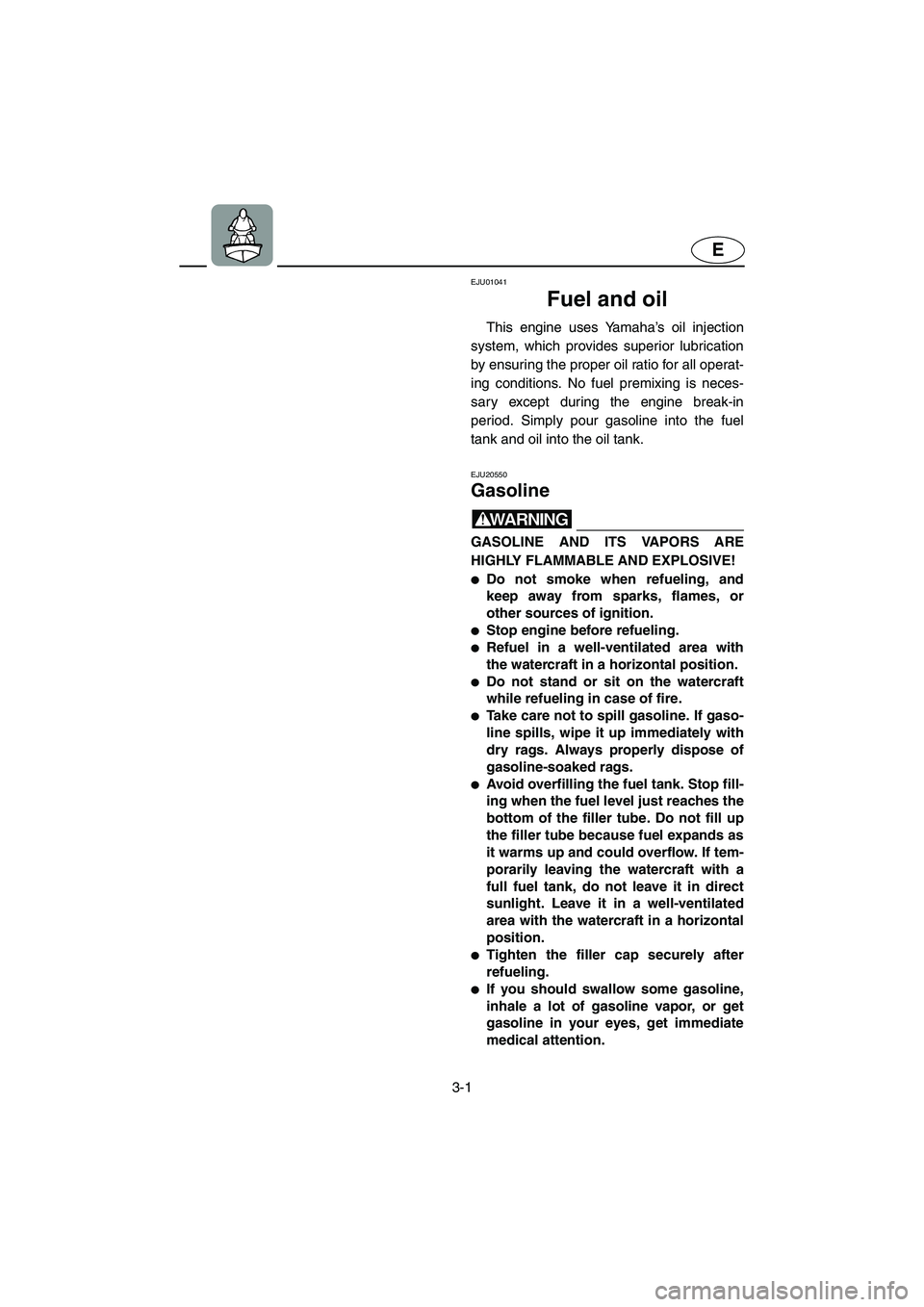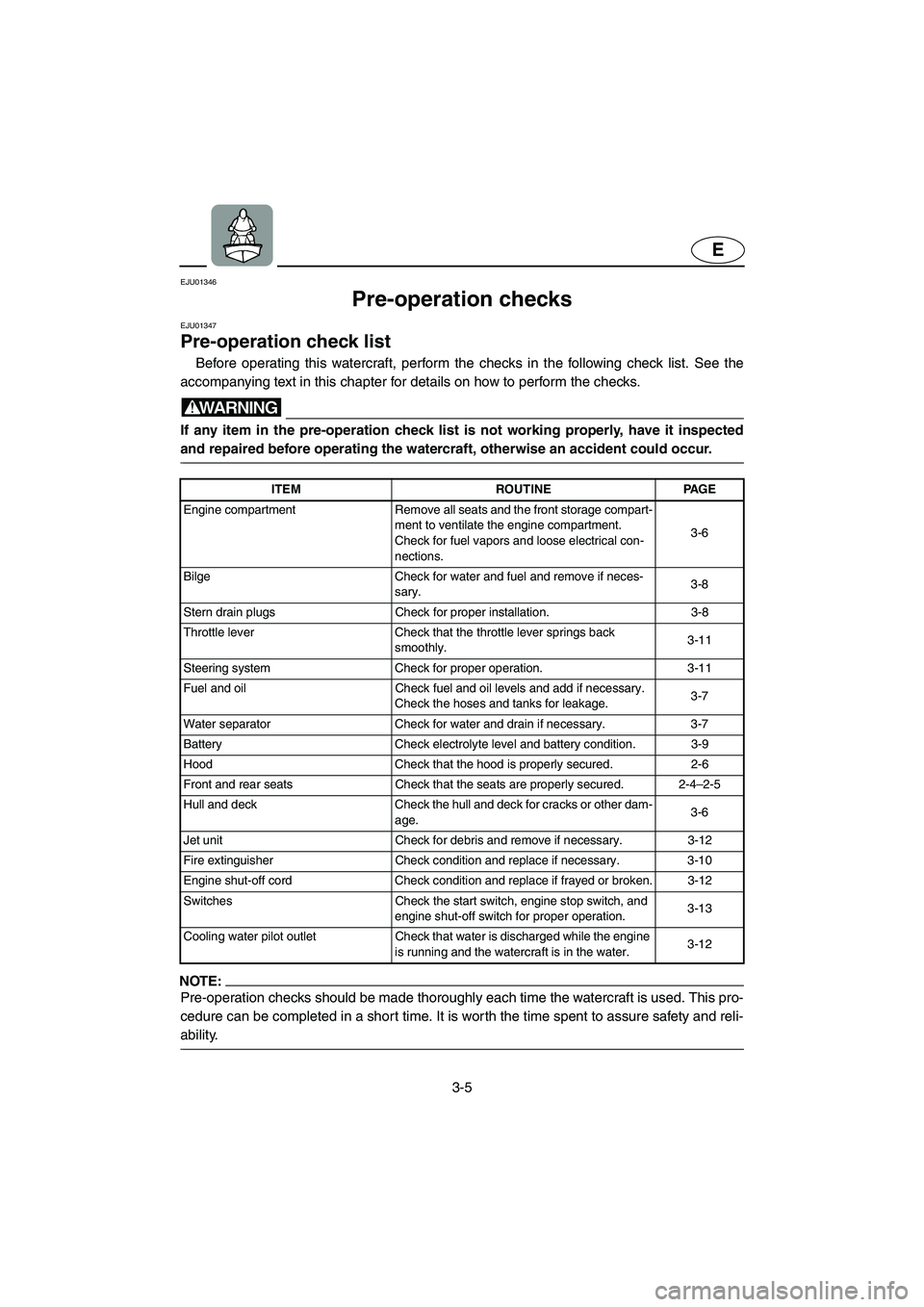Page 38 of 120
2-13
E
EJU01131
Engine overheat warning
system
This model is equipped with an engine
overheat warning system.
If the engine starts to overheat, the
engine speed will be limited to about
3,400 r/min.
When this occurs, check for water dis-
charge at the cooling water pilot outlet. If
there is no discharge of water, reduce the
engine speed and beach the watercraft, and
then check the intake grate and impeller for
clogging.
WARNING@ Before attempting to remove weeds or
debris from the intake grate or impeller,
shut the engine off and remove the clip
from the engine shut-off switch. Severe
injury or death could result from coming
in contact with the rotating parts of the
jet pump.
@
CAUTION:@ If you cannot locate and correct the
cause of the overheating, consult a
Yamaha dealer. Continuing to operate at
higher speeds could result in severe
engine damage.
@
UF0M75.book Page 13 Thursday, May 29, 2003 9:53 AM
Page 39 of 120
2-14
E
EJU01132
Oil level warning lamp
If the oil remaining in the tank drops to
about 1.2 L (0.31 US gal, 0.26 Imp gal) or
the oil filter is clogged, the oil level warning
lamp begins to blink.
If the oil level warning lamp begins to
blink, refill with engine oil as soon as possi-
ble.
NOTE:@ �The lamp will light up for 2 seconds after
starting the engine to check the lamp
operation.
�If the warning lamp blinks with adequate
oil in the tank, check for a clogged oil fil-
ter.
@
UF0M75.book Page 14 Thursday, May 29, 2003 9:53 AM
Page 44 of 120

3-1
E
EJU01041
Fuel and oil
This engine uses Yamaha’s oil injection
system, which provides superior lubrication
by ensuring the proper oil ratio for all operat-
ing conditions. No fuel premixing is neces-
sary except during the engine break-in
period. Simply pour gasoline into the fuel
tank and oil into the oil tank.
EJU20550
Gasoline
WARNING@ GASOLINE AND ITS VAPORS ARE
HIGHLY FLAMMABLE AND EXPLOSIVE!
�Do not smoke when refueling, and
keep away from sparks, flames, or
other sources of ignition.
�Stop engine before refueling.
�Refuel in a well-ventilated area with
the watercraft in a horizontal position.
�Do not stand or sit on the watercraft
while refueling in case of fire.
�Take care not to spill gasoline. If gaso-
line spills, wipe it up immediately with
dry rags. Always properly dispose of
gasoline-soaked rags.
�Avoid overfilling the fuel tank. Stop fill-
ing when the fuel level just reaches the
bottom of the filler tube. Do not fill up
the filler tube because fuel expands as
it warms up and could overflow. If tem-
porarily leaving the watercraft with a
full fuel tank, do not leave it in direct
sunlight. Leave it in a well-ventilated
area with the watercraft in a horizontal
position.
�Tighten the filler cap securely after
refueling.
�If you should swallow some gasoline,
inhale a lot of gasoline vapor, or get
gasoline in your eyes, get immediate
medical attention.
UF0M75.book Page 1 Thursday, May 29, 2003 9:53 AM
Page 47 of 120
3-4
E
EJU01328
Filling the oil tank
WARNING@ �Do not add gasoline to the oil tank.
Fire or explosion could result.
�Oil in the bilge is a serious fire hazard.
Wipe up any spilled oil immediately.
@
CAUTION:@ Do not allow the oil tank to become com-
pletely empty. If the oil tank becomes
empty the oil injection pump must be
bled to ensure proper oil flow, otherwise
engine damage may occur. If bleeding of
the oil pump is necessary, have a
Yamaha dealer bleed it.
@
1. Open the hood and remove the front stor-
age compartment. Also, remove all seat,
so you can watch the oil level. (See page
2-6 for hood, and pages 2-4 and 2-5 for
seats.)
2. Open the oil tank filler cap, and very
slowly add engine oil to the oil tank.
3. Stop pouring when the oil just reaches
the bottom of the filler tube.
Oil tank capacity:
3.8 L (1.0 US gal, 0.8 Imp gal)
UF0M75.book Page 4 Thursday, May 29, 2003 9:53 AM
Page 48 of 120

3-5
E
EJU01346
Pre-operation checks
EJU01347
Pre-operation check list
Before operating this watercraft, perform the checks in the following check list. See the
accompanying text in this chapter for details on how to perform the checks.
WARNING@ If any item in the pre-operation check list is not working properly, have it inspected
and repaired before operating the watercraft, otherwise an accident could occur.
@
NOTE:@ Pre-operation checks should be made thoroughly each time the watercraft is used. This pro-
cedure can be completed in a short time. It is worth the time spent to assure safety and reli-
ability.
@
ITEM ROUTINE PAGE
Engine compartment Remove all seats and the front storage compart-
ment to ventilate the engine compartment.
Check for fuel vapors and loose electrical con-
nections.3-6
Bilge Check for water and fuel and remove if neces-
sary.3-8
Stern drain plugs Check for proper installation. 3-8
Throttle lever Check that the throttle lever springs back
smoothly.3-11
Steering system Check for proper operation. 3-11
Fuel and oil Check fuel and oil levels and add if necessary.
Check the hoses and tanks for leakage.3-7
Water separator Check for water and drain if necessary. 3-7
Battery Check electrolyte level and battery condition. 3-9
Hood Check that the hood is properly secured. 2-6
Front and rear seats Check that the seats are properly secured. 2-4–2-5
Hull and deck Check the hull and deck for cracks or other dam-
age.3-6
Jet unit Check for debris and remove if necessary. 3-12
Fire extinguisher Check condition and replace if necessary. 3-10
Engine shut-off cord Check condition and replace if frayed or broken. 3-12
Switches Check the start switch, engine stop switch, and
engine shut-off switch for proper operation.3-13
Cooling water pilot outlet Check that water is discharged while the engine
is running and the watercraft is in the water.3-12
UF0M75.book Page 5 Thursday, May 29, 2003 9:53 AM
Page 49 of 120
3-6
E
EJU01048
Pre-operation check points
EJU01728
Engine compartment
Ventilate the engine compar tment before
each use.
To ventilate the engine compartment,
remove the front seat and front storage com-
partment. (See page 2-5 for front seat, and
2-15 for front storage compartment.) Allow
the engine compartment to remain open for
a few minutes to allow any fuel vapors to
escape. Also, check for loose electrical con-
nections.
WARNING@ Failure to ventilate the engine compart-
ment could result in fire or explosion. Do
not start the engine if there is a fuel leak
or a loose electrical connection.
@
EJU20570
Hull and deck
Check the hull and deck for cracks or
other damage. If any damage is found, have
a Yamaha dealer repair the watercraft.
UF0M75.book Page 6 Thursday, May 29, 2003 9:53 AM
Page 52 of 120
3-9
E
EJU01969
Battery
Check the battery condition and the elec-
trolyte level.
Check that the battery leads are tightened
securely and there is no corrosion on the
battery terminals.
WARNING@ �The battery must always be fully
charged and in good condition. Loss
of battery power may leave you
stranded. Never operate the watercraft
if the battery does not have sufficient
power to start the engine or if it shows
any other signs of decreased power.
�Be sure to connect the breather hose
to the battery. Fire or explosion could
result if the breather hose is damaged,
obstructed, or not connected properly.
@
Make sure that the battery is securely
held in place.
1
Positive (+): Red lead
2
Negative (–): Black lead
3
Breather hose
UF0M75.book Page 9 Thursday, May 29, 2003 9:53 AM
Page 54 of 120
3-11
E
EJU01834
Throttle
Squeeze and release the throttle lever
several times to make sure that there is no
hesitation in its travel. It should be smooth
over the complete range, and spring back to
the idle position when released.
WARNING@ Before starting the engine, always check
the operation of the throttle lever.
@
EJU01057
Steering system
Check for looseness in the handlebars.
Turn them as far as possible to the right
and left to make sure that operation is
smooth and unrestricted throughout the
whole range. Make sure that the jet thrust
nozzle also changes directions as the han-
dlebars are turned, and that there is no free
play between the handlebars and the jet
thrust nozzle.
UF0M75.book Page 11 Thursday, May 29, 2003 9:53 AM